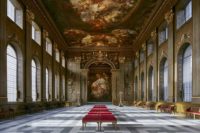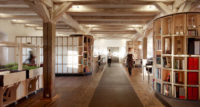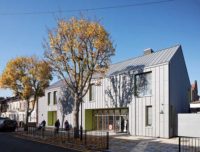When Hugh Broughton Architects won a design competition for the Halley VI Antarctic research station, which officially opens today, the small London-based office had no experience working in extreme environments. But its proposal, developed with engineer AECOM, impressed the jury both for its technical ingenuity and its understanding that for up to 50 scientists, this inhospitable place is home.
British Antarctic Survey (BAS) established the Halley research station on the Brunt Ice Shelf in 1956. Its first four bases were lost to the ice, which piles up relentlessly – over three feet each year – burying and eventually crushing any building sitting on the ground. A fifth was constructed on steel legs that could be laboriously elongated, but after 20 years of service, the legs are encased in 75-feet of ice and break when it moves.
For Halley VI, BAS wanted an easier way to stay clear of the terrain. Broughton’s solution was to place eight modules on extendible hydraulic legs. The legs are retracted one by one, and three feet of snow is piled underneath each of them. Extending their legs again, the buildings haul themselves clear of the rising ground for another year.
The design of the new station also solves another key problem: the ice shelf itself flows towards the ocean, a quarter mile each year. Buildings that cannot be moved have a 10-year lifespan. Halley VI’s legs are fitted with giant skis; when the time comes, the modules will be towed inland by bulldozers.
Linked by short, flexible corridors, the modules stand in line like a desert caravan, perpendicular to the direction of the prevailing wind, which drives snow from underneath. Living accommodations and laboratories, clad in blue glass-reinforced plastic, are positioned on either side of a larger unit clad in red.
This red module contains a social space that is crucial to the wellbeing of the small crew who live at Halley year-round. Brutal winter conditions of permanent darkness, -60-degree temperatures, and 100-miles-per-hour winds leave them vulnerable to depression and stress – “winter-over syndrome.” Home comforts include a hydroponic salad garden and a climbing wall within a double-height central space lined with Lebanese cedar, selected for its scent. The architect also worked with a color psychologist to identify “refreshing and stimulating” shades, and developed a bedside lamp with a daylight bulb to simulate sunrise.
“It has been a fascinating project,” says architect Hugh Broughton, “because it combines microscopic examples of many different building types – an operating theater, air traffic control, a power plant – rolled into 20,000 square feet.” The opportunity to visit the pristine wilderness was another benefit for which the architect is grateful. Since Halley VI has led to similar projects for Spanish, Indian, and Korean scientists, that adventure may not be over.









Post a comment to this article
Report Abusive Comment